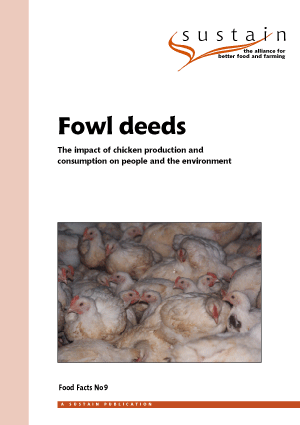Fowl Deeds (Food Facts No. 9)
The impact of chicken production and consumption on people and the environment (2000)
Between 700 and 750 million broiler chickens (chickens bred for their meat) are reared and slaughtered each year in the UK. This report looks at the impacts of their production on people and environment.
- 98% of all broiler chickens are reared in intensive indoor systems and less than 2% are free-range or organic.
- Broilers live for around 43 days in one shed at stocking densities of around 34 kg / m2. In their last week of life this is equivalent to each bird having the space of a piece of paper the size of this page to live on.
- A report in 1992 showed that 90% of broilers (at slaughter age) had leg problems. Over 1 in 4 birds "suffered an abnormality of sufficient severity that their welfare was compromised" and over 1 in 20 birds had such poor legs, they would normally be destroyed.
- Broilers are kept in sheds with low levels of light. Access to natural daylight is rare.
- On arrival at the processing plant, the chickens are shackled upside down on a moving line.
- The chickens are stunned in an electric water bath. The stunning is not always effective, so some birds are still conscious when their necks are cut. If both arteries are not cut in the neck, some birds survive long enough to enter the scalding tank alive. Over 8,000 birds can be processed every hour in one plant.
- Many academics, government bodies and non government organisations believe that the chickens suffer excessively throughout their lives. Breeding broilers also suffer from serious welfare problems. The economics of the broiler industry are always placed before the welfare of the birds. There is no specific legislation to protect the welfare of broiler chickens. In 1997, Justice Bell found that McDonalds Restaurants and their supplier used cruel practices when broiler chickens were reared and slaughtered. l The spread of disease is a common problem, both in the rearing sheds and at all levels of the processing plant. The most common bacteria to cause food poisoning in the UK is Campylobacter which causes 400,000 incidences a year, of which over one-third may be attributable to chicken meat. Salmonella infects over one-third of all chickens.
- Human health is at risk with around 40% of chickens still containing Salmonella or Campylobacter. Nearly half a million people fall ill from Campylobacter poisoning, a third of which probably came from chicken meat. This is not surprising as Sustain also discovered that 40% of all poultry slaughterhouses failed to "comply satisfactorily with all statutory hygiene requirements"3 and 8% had very poor hygiene standards.
- Raw chicken is dangerous to eat and should always be prepared correctly. Barbecued chicken should always be pre-cooked.
- One third of all broiler litter waste is burnt for power generation and the rest is spread on agricultural land. Broiler litter can pollute the environment from nutrient leachate, heavy metals and pathogens.
- Organophosphate insecticides are frequently used by contract workers when cleaning out sheds. This has led to serious incidences of health and environmental pollution.
- Air pollution in broiler houses creates unacceptable levels of ammonia and dust which can cause problems for the broilers, workers, and the local environment.
- Supermarkets dominate the retailing of broiler chickens. Surprisingly, some of the supermarkets did not have a policy on the welfare of chickens during production, on genetically modified ingredients in chicken feed, or on a strategy to reduce bacterial contamination of chicken meat.
- Imports of chicken increased from under 22,000 tonnes in 1980 to over 300,000 tonnes in 1998. The most recent increases in imports have come from Thailand and Brazil, which appear to have lower standards of both hygiene and animal welfare.
- There are many alternatives to intensive broiler chicken meat. These include, RSPCA Freedom Foods, Free-Range and Organic systems which are detailed in the table Comparison of broiler systems.
Published Sunday 31 August 2003
Food Facts: A series of short reports on over a dozen different products, shows how people's shopping choices - as well as government policy - can protect the environment, enhance social justice and improve health.
